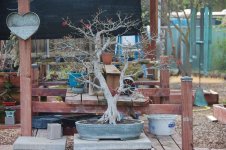Anthony_Jamez12
Seedling
Just curious, what are the holy grails of tree species for Bonsai? Something hard to get your hands on. Tricky to cultivate, or maybe something that was once close to extension? (If any of this is even a thing)
Something hard to get your hands on. Tricky to cultivate,
There is no answer to this since all woody stemmed trees and shrubs can technically be grown using bonsai cultivation. "Rare" depends on where you are. Some people like Asian species that are kind of common in Japan bonsai but not used in North America. Bald Cypress, live oak and white cedar are rare in Japan...
Something hard to get your hands on. Tricky to cultivate [emphasis added]
Fair enough, but when it comes to the West, we have so many species that haven't been tried, it's a Turkey shoot as to what the "Holy Grail" would be. Swamp tupelo, American Snowbell, white oak, black haw are a few that come to mind for me. All those species live around me. All are "rare" in bonsai because not many people dig them up and try to make them bonsai. All can make decent bonsai. Some are rare in the woods, others common. The common ones can be unremarkable and not worth collecting. A middling trunk on a rare species makes it worth the trouble.That's a good answer to the 'holy grail' part of the question. But there is also this part of the question, which most people I meet do have a fair answer to:
Curious what yours areI named 5 above from Japan, but I can say there are North American species that grow 50' from my house that I would put in this category too, like White Birch, not because it's difficult to find but because it's difficult to find a nice one and can be tricky to cultivate -- you could say it is a 'holy grail' to me, in the sense that it is elusive and sought-after




I agree. Another "elusive" American species is the female (fruit-bearing) American holly. Elusive for two reasons - first, because in the wild you will only find 1 female for about every 20 males. Second, because nurseries don't like stocking native (natural) species because they don't sell. People typically only want "special" cultivars, or distinctive plants. I have yet to see a single American holly for sale in any nursery... however I have seen numerous Chinese and Japanese hollies - of multiple cultivars.I can say there are North American species that grow 50' from my house that I would put in this category too, like White Birch, not because it's difficult to find but because it's difficult to find a nice one and can be tricky to cultivate -- you could say it is a 'holy grail' to me, in the sense that it is elusive and sought-after
